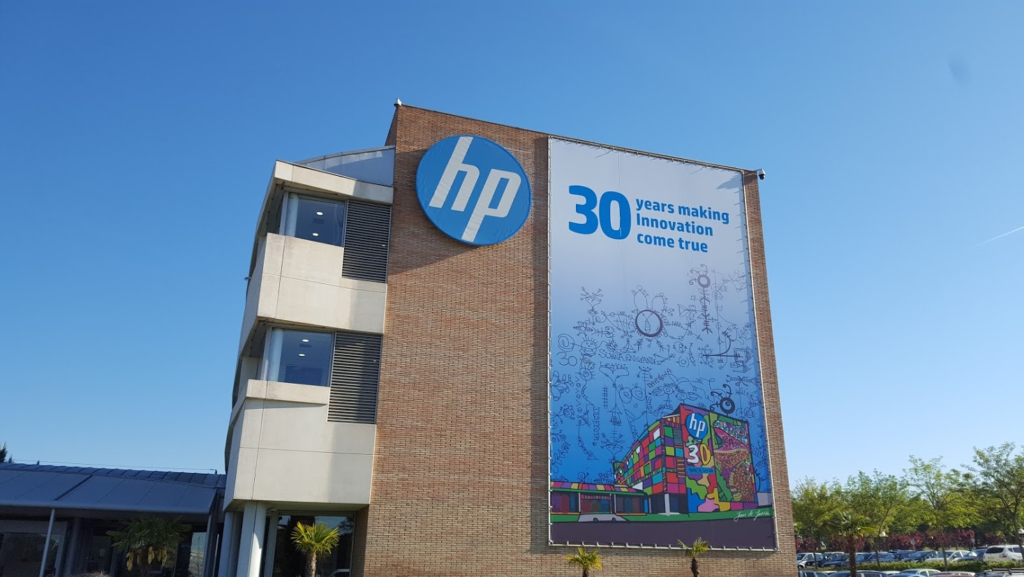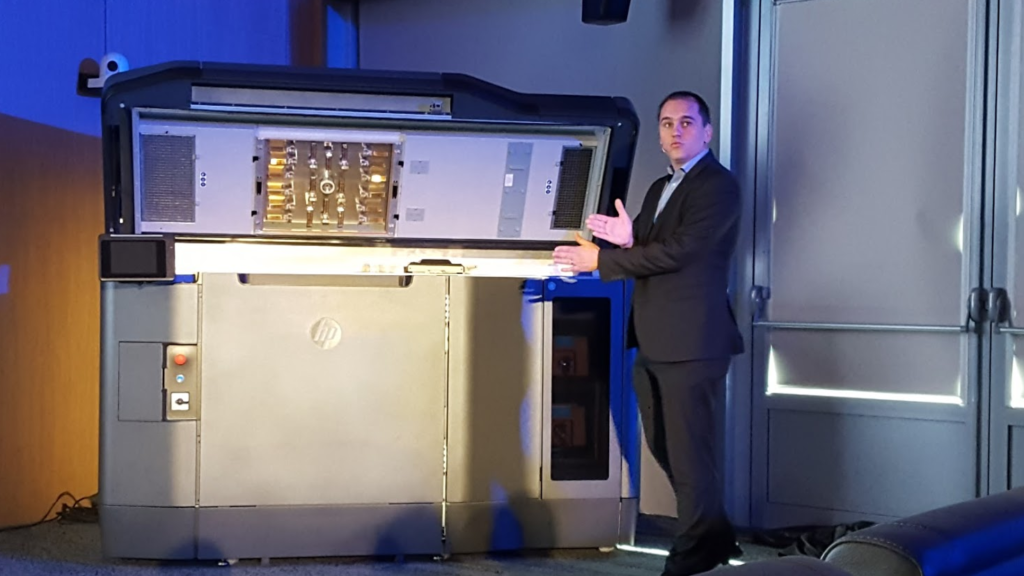Two weeks ago in Barcelona, I had the phenomenal opportunity to see the just-unveiled HP Multi Jet Fusion 3D printer in person. While my first glimpse of it was in a presentation, with the printer and processing station sitting shiny and new in their respective corners of a room built more for PowerPoint than for industrial printing, the team at HP were also aware that the best way to really learn about new tech is to see it in action, and to hear from those behind it about its development — and so the dozen journalists and analysts gathered in sunny Spain also had the unique experience of touring the private HP 3D printing labs, where we saw ten of the MJF machines in action.
Afterward, I was able to sit down and hear directly from some of the executives behind the entire 3D printing business there at HP, and found out more information directly from Stephen Nigro, President of HP Inc.’s 3D Printing Business, and from J Scott Schiller, Vice President of Market Development. Talking to these two execs who have been with the process of developing the all-new MJF technology certainly helped to shed some light on the entire process. When HP set out to re-invent 3D printing, they truly meant it — and the biggest key to their process was listening to customers and learning what the market wanted. As a 2D powerhouse for decades, the company had significant experience to draw from so far as product development. 3D is, of course, its own field, and as a company stepping in to enter in a big way, HP took step back to truly devote themselves to the R&D necessary to discover everything available to them so far as both customers and technology are concerned. HP isn’t looking to simply enter the market; the plan is to lead the market.
Stephen Nigro, in a session at HP Barcelona, presented to us a scenario indicative of some of the opportunities and thought processes among thought leaders in the tech community: at CES, a huge tradeshow and hot-spot for tech, at the end of the day, a massive line forms at the end of the long, busy day of conference activity. This line is at the taxi stand, as everyone seeks to return to the refuge of their hotels. As Nigro joined the line, which had an estimated wait time of 45 minutes, he realized he had another option: he pulled out his phone, called an Uber driver, and was picked up within minutes. As he pulled away, he saw that the line at the cab stand had barely dwindled, full of high-powered experts in a variety of high-tech fields. This example illustrated to him a primary point: a choice has to be made in adopting new solutions. In much the same way, the adoption of HP’s MJF 3D printing technology will necessarily be a choice by those who might benefit from the technology.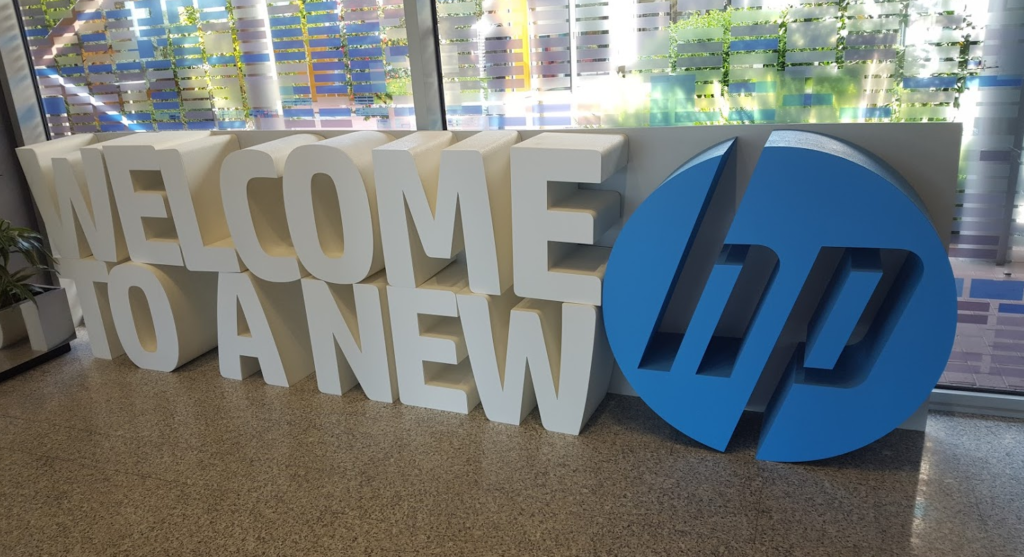
“Soon enough, I’ll be looking at stuff and thinking, was this 3D printed or not?” Nigro told me from across a table, holding up his pen (which was not 3D printed). I asked when he thought that question would be asked more frequently. “Mainstream? I’d love it to be sooner than later. I don’t know. To be honest, I don’t know the answer to that question. The world will be embracing 3D and how it works, for sure, even more so. The big question is not if, it’s when. That’s really the exciting thing here, you know it’s going to happen, you see the opportunity. There’s a lot of pieces — behaviors have to change, it can be shocking how long it takes people to change behaviors. You have to make that conscious choice, people will have to make that conscious choice to change.”
And here’s where his Uber analogy came in to play. What was it, I asked, that had made him pick up the phone that first time he called an Uber rather than wait for a cab?
“It’s kind of who I am,” Nigro told me. “I like to try new things. I think for me to be a high-tech executive I’m always reading about high-tech trends and want to try new things. I don’t necessarily always get them, I don’t get Twitter. If you look at my Twitter account, I’m not active, because I haven’t gotten it. I’m very active on Facebook… I always want to try the new things. There’s that intellectual curiosity, definitely — how do things work? Part of it is, if you’re going to be a leader in high-tech, you’d better be personally experiencing it, because that helps you be a leader. I can tell you, that whole open materials, open platform? It would have been very easy to do what we have done in our current business. It was kind of interesting. That decision was made maybe a week before our announcement in October [2014]. We were on a phone call getting ready and I’m like, ‘Guys, we’re going open’. They said, ‘Ahh, no, what, Steve, why’ and I told them, ‘The world’s open, the world’s open. If we’re building a business for the next 10 years, 15 years, 20 years, we better be open.’ We can’t build our business like we have in the past. If you’re going to be leading, going to be thinking, you have to really understand how the world works versus how it worked.”
Building up the new business — as an open platform, no less, a new approach for HP — required taking a big step back and engaging the entire team’s intellectual curiosity. Talking with Scott Schiller provided an interesting perspective on just how critical this curiosity was. Not just asking the right questions, but in asking them of the right people, at the right time. Where are the opportunities, and how are they best approached?
“I would say the thing that we’ve become pretty good at as a company that is both a material science company and a computer tech company is understanding what we’re really good at and trying to take both the technology out as well as take the customer view in, and kind of work that back and forth until we identify areas where things really seem to connect,” Schiller explained to me. “That’s what drove us to the four applications, the four verticals, that we identified. Within those, then you have to really start drilling down to use cases. I think one theme we see very clearly is there’s a lot of opportunity in aftermarket, spare parts, and that’s sort of a theme that plays across the verticals, so that’s an area we’ll be paying a lot of attention to. … That’s really the secret sauce in driving technology adoption. If we’ve learned anything over the last 15 years, it’s that you have to remove the points of friction. There’s lots of people who can say no when it comes to making these purchases, and you have to remove as many of those points of friction to get the technology in the door. Once it’s in, then people start to get really creative with it and it actually blooms. A lot of times what people try to do is focus on the super-unique, artistic application as the thing to get everybody focused on, but you never get past the person who can say no. We’ve learned that it really comes down to economics.”
A key part of HP’s approach to entering the market is in doing so viably. To that end, they identified four key verticals, as Schiller referenced above, that will form the basis of their focus upon entry. Aerospace/defense, automotive, medical/dental/life sciences (health care), and a variety of consumer applications will form the foundation upon which this entry is built. A key component of each of these verticals lies in the value of application- or patient-specific creations which are indeed well-serviced by additive manufacturing technologies.
“All of these are — to call them a vertical is a bit of a misnomer, these are massive, massive industries,” Schiller told me. “And so we have a lot of work to really dig down. The process that we work through is we both have very systematic, McKinsey-esque kinds of approaches to market analysis, very analytical. At the same time, we like to balance that with people who really understand the use cases. In the end, it’ll come down to the parts, the use cases, the value that’s created. There’s a bit of a simultaneous top-down, bottom-up approach and we’ve found that to be the most successful mechanism. The other thing I mentioned that I think is important is to always have a bit of diversity in your strategy, but not too much. Focus is really critical. To be transparent, it’s still very early days in terms of understanding — the way we think about our organization is that we’ve got a good group of people who really understand the traditional uses of 3D printing, for rapid proto and things like that, but we also need to have advanced teams that are looking at intermediate applications, tooling, bridge production, and ultimately to final part manufacturing.”
In listening to their customers and working to truly create a working AM solution that would provide end-to-end solutions — a point that all HP presentations in Barcelona kept coming back to is that this is a complete approach to a solution, and formed to keep economics at its heart — the development of the system changed from the initial announcement in October 2014 through the system being unveiled today at RAPID, and seen in the labs in Barcelona as well as in beta customers’ labs for some months now. I had personally been surprised by the two-machine system represented in the MJF solution. How did that come to be? Nigro told me about some of his thoughts on the anticipated reaction upon its unveiling, and how pre-announcing their entry to market turned out to be a benefit:
“I think they’ll see that we’re designing more than a machine, we’re designing an end-to-end experience. It’ll take a bit of education. Like when you guys first saw it, you weren’t quite sure how it all works together. But once you understand it, you can see — and you can also see how it’s very much targeted at scaling. And again back to this learning. That was not part of our plan when we first announced it back in 2014. I mean, we knew we needed something post-processing, but not this sort of solution — that was only through this agile customer engagement process, interacting with customers real time in our lab and we realized there was this pain point here and we ended up developing this. It definitely came on relatively early. It’s really the benefit of almost pre-announcing, we had nothing to lose in our case. The risk you run when you pre-announce something new, everything that’s old, you quit selling because everyone’s going to wait for the new thing — but 3D, we had nothing. We were new to the market. Pre-announcing let us engage and learn a lot about the market.”
Schiller, as I spoke with him, also touched upon these points in a way. Honing in on the critical nature of listening to customers, we talked about how Shapeways was a great testing field for MJF technology. Shapeways’ CEO, Peter Weijmarshausen, spoke to us in Barcelona as well, with some familiar slides from his presentation at Inside 3D Printing NYC last month, as he shared his vision of 3D printing’s place in the next industrial revolution. It was no accident that HP and Shapeways were working together, as Schiller noted that people like Weijmarshausen stand out as beacons in the industry.
“It’s a funny thing,” Schiller said, “because there was a point where we had the observation that we had amazing technology essence. We had this modular thermal inkjet architecture and we knew, we knew that it would apply to market spaces we had never participated in before. So the question is, what is the best way to identify how to participate in those markets? And I think historically what people do is kind of derivative. They take an incremental step relative to what they’re doing right now and what they know right now. I think the thing that we did that was different is we stepped way back and tried to look at the bigger picture, and understand what is the most profound application of this technology, and identified real thought leaders in the industry. We do that in 3D, we did that in 2D, and these are the folks — there’s just a certain profile, you know them when you see them. Peter is exemplary, he’s a real thought leader, he knows how to just make things happen. He has a vision and knows how to get people behind that vision. I think one of things that’s most important about what he does is everything he does is for the customer, they take it to such extremes. I think for us it was a similar approach. We worked really, really closely with the customers and just listened.”
In speaking with customers and with thought leaders like Weijmarshausen, HP was able to draw from traditional experience and see how they might optimize future experiences.
“Something that Peter started hitting on is something that we see is a really critical trend, and that is — we were talking with, we’ll say a really, really large appliances company,” Schiller said. “One of the things they shared with us is that historically they can’t entertain the idea of a new product unless it’s going to sell hundreds of thousands. And the problem is, is that a lot of times you don’t get to hundreds of thousands of sales of something unless you have a period of ramping it up. There’s been a big gap in between. What they see as the promise of 3D printing is to be able to help bridge that gap, and at the same time allow for more innovative processes in that gap, and out of that should come a lot more variation of products that are offered and then as a derivative of that, what you’re going to see is that things will be less homogeneous, more varied. All of that is suited for additive manufacturing.”
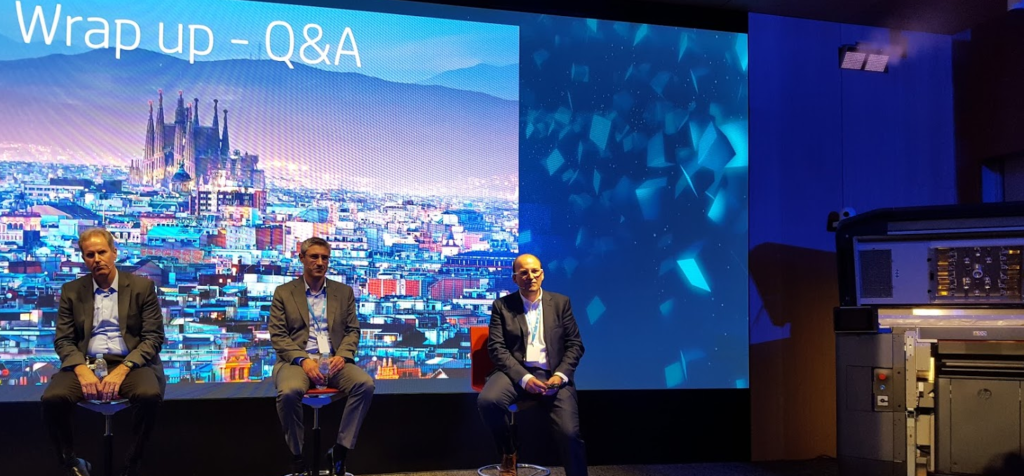 HP is already working with four materials companies to develop powders with different capabilities, and these suppliers bring significant expertise to the table that HP has been finding invaluable — and which they hope to see more of as time rolls on. In discussing their open approach to materials capabilities, I asked Nigro when he thought that platform might start appealing to even more suppliers.
HP is already working with four materials companies to develop powders with different capabilities, and these suppliers bring significant expertise to the table that HP has been finding invaluable — and which they hope to see more of as time rolls on. In discussing their open approach to materials capabilities, I asked Nigro when he thought that platform might start appealing to even more suppliers.
“Pretty quick. Two of the four have come on in just the last three months. Two months? It’s another story behind a story. Once we announced it, we had to figure it out. For an open platform to work, people have to benefit from being on it. Why would they be on it if they’re not benefiting from it? We had to figure out the business model, answer a lot of questions, be very agile in rolling it out, talking with them. We learned a lot, we learned a lot. Probably the biggest thing we learned in talking with materials suppliers, these specialist material companies, is — this is what they do. Probably the biggest learning for me is what they do is develop vertical applications. If I’m creating a material I have to then go and figure out how to use it in aerospace or consumer products. They’re really good at it. We have a lot to gain. By leveraging these material providers who are going to be on our open platform, we’re really going to benefit from that in a unique way. One of the four said to us one night at dinner: ‘We want the world to know that we’re partnered with you on your platform.’ We were trying to figure this out, and said, Well, why? ‘Well, we want to go tell all our customers that we’re partnered with HP on Multi Jet Fusion and that we want to develop new applications with our customers.’ That’s a really good reason. That was a learning for us — we didn’t know that, we were thinking we were going to have to build all these vertical expertise and we still have to develop some. I won’t get into numbers, but we looked at numbers on one industry and thought, my gosh, we’ll never have that many people in that industry. That was one company. So I think the real benefit to us was looking at that learning process and leverage the world, leverage what people do well. I think we’ll get more and more. I hope there is. There’s no other way we’ll get the breadth of material choices necessary to really have this thing in manufacturing production.”
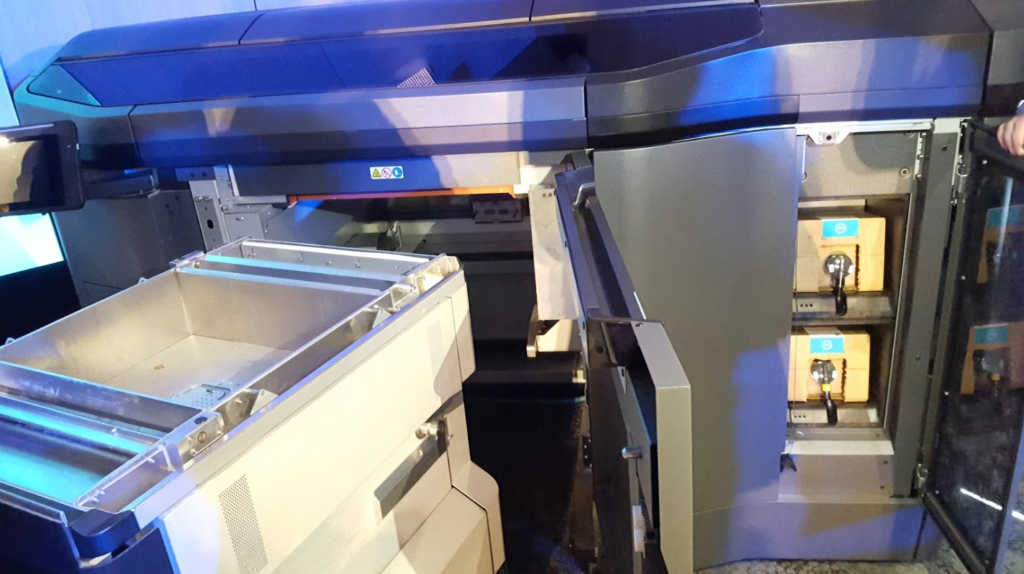 Nigro additionally filled me in on some of his thoughts about the capabilities and future of the software necessary for the future of 3D printing:
Nigro additionally filled me in on some of his thoughts about the capabilities and future of the software necessary for the future of 3D printing:
“Well the software, we’ll definitely be shipping the up-front experience with the customer, definitely hitting that end-to-end solution, I think that’s a great starting point for us. I think what’s exciting is the potential for the software. What’s exciting is ultimately it’s going to be a battle. How do you use the power of the cloud, compute, store, come up with new designs and have assisted designs… I think that’s so nascent. It’s a little of this chicken-and-egg. People now suddenly are going to be able to design parts in a way they’ve never been able to design before, because you couldn’t make it. I think the creative element of software is super exciting. I think this is going to be a great opportunity for somebody in the industry to become a leader.”
Of course, all of this is based on the idea of economic viability; it’s no use having a great product if it’s not going anywhere. A primary benefit of AM is its ability to do more than injection molding can, in terms of geometries, customization, and other creations that require no molding.
“We work a little bit with the Ellen MacArthur Foundation, which is focused on the circular economy,” Schiller told me. “The whole premise there with our technology is we have the opportunity to make things that are fundamentally more valued — personalized, customized, whatever. By virtue of it not being homogeneous it is more likely to be valued and as a result of that is less likely to be thrown away or wasted. The world of homogeneity where everybody gets the same thing is a pretty wasteful world. We see a great opportunity to drive higher value and less waste.”
Breaking the mold (pun intended) and taking us away from a homogeneous workplace, the HP MJF system certainly sounds promising. And, yes, it looks incredible — watching it in action and holding printed pieces was quite an experience. In all, then, I had only one question left to ask:
What is your personal favorite thing about the machine itself?
Schiller:
“I just love watching it work. I think all of us are a bit captivated in the idea that you can build things up rather than the traditional world of cutting things down and molding and milling away. The fact that now you get geometric complexity as much as you want — the possibilities there are profound and inspiring.”
Nigro:
“I would say my favorite thing about the new product is what it can produce. I mean, the machine and the product is all kind of cool and blah blah blah, but what matters is what actually it produces. It can look good, it can be slick, it can be attractive, but what can it actually make? It’s the beauty that will be in seeing what comes off the machine. It’s about the output.”
That’s a lot of great information to soak in from HP! What are your thoughts on the new technology? Tell us in the HP Discusses New 3D Printing Technology with 3DPrint.com forum over at 3DPB.com.
[All photos taken on-site at HP in Barcelona by Sarah Goehrke]Subscribe to Our Email Newsletter
Stay up-to-date on all the latest news from the 3D printing industry and receive information and offers from third party vendors.
You May Also Like
3D Printing News Briefs, April 13, 2024: Robotics, Orthotics, & Hypersonics
In 3D Printing News Briefs today, we’re focusing first on robotics, as Carnegie Mellon University’s new Robotics Innovation Center will house several community outreach programs, and Ugogo3D is now working...
Rail Giant Alstom Saves $15M with 3D Printing Automation Software 3D Spark
3D Spark has entered into a three-year deal with the rail giant Alstom. Alstom, a transport behemoth with annual revenues of $16 billion, specializes in the manufacture of trains, trams,...
Meltio Expands Global Reach with New Partnerships in the Americas and Europe
Spanish 3D printing manufacturer Meltio has expanded its sales network across the globe. With the addition of three new partners in the United States, Brazil, Argentina, and Italy, Meltio aims...
3D Printing Webinar and Event Roundup: April 7, 2024
Webinars and events in the 3D printing industry are picking back up this week! Sea-Air-Space is coming to Maryland, and SAE International is sponsoring a 3D Systems webinar about 3D...


